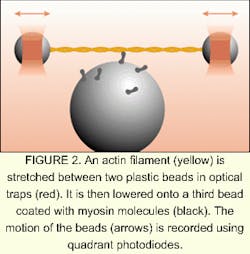Researchers in the department of biology at the University of York (York, England) have used a combination of new imaging technology and optical tweezers to study muscle contraction at a microscopic level. Their investigations have allowed them to measure the minute forces and movements produced by single protein molecules as they split a single fuel molecule. Such research is helpful to the understanding of how the family of proteins in the human body known as "molecular motors" work to produce the forces and movements that are crucial to all living things and are involved in cell division, muscle contraction, sperm motility, cytokinesis, and vesicular transport.
Muscles are linear motors that convert chemical energy to mechanical work. Muscle tissue consists mainly of the proteins actin and myosin, which form highly organized arrays of interdigitating polymer filaments about 1 µm long. Movement comes from the pull exerted by myosin molecules on actin, and muscles contract as the filaments of the two molecules slide past each other. Tiny movements in individual molecules are amplified to become bulk movements. The "fuel" for the motor comes from hydrolysis of adenosine triphosphate (ATP), which is used one molecule at a time.
The York system was originally developed by researchers Justin Molloy and David White, and is sensitive enough to measure the picoNewton forces and nanometer movements produced by individual proteins. In their experiments, optical tweezers are used to manipulate two 1-µm-diameter plastic beads, and are used to hold a single actin filament strung between them (see Fig. 1). To measure the force produced as a single molecule of fuel (ATP) is broken down, the actin filament is brought close to a third fixed bead that is sparsely coated with myosin. When the two proteins interact, ATP is split and a small mechanical kick is produced.
Infrared (IR) light from the fundamental wavelength of an Nd:YAG laser is used to produce the optical traps (see Fig. 2). Just a few milliwatts of focused laser light are required to produce sufficient photon pressure to trap and manipulate micron-sized particles. Because the IR light is poorly absorbed by water and biological samples, it produces little heating or damage. The laser beam is focused through a high-numerical-aperture microscope objective lens mounted on a Zeiss Axiovert microscope. This produces a small spot of light with a steep gradient of intensity around its focus. Objects with a refractive index greater than the surrounding medium, such as polystyrene beads in water, are attracted to the region of highest light intensity; in fact, they are pushed to this point by photon momentum. Acousto-optic deflectors are used to steer the laser beam and move the trapped object. To produce multiple optical traps, the beam is rapidly moved between different positions—a form of multiplexing, synthesizing independently controllable individual traps.When the muscle proteins exert force, the beads are displaced from the focus and the small movements, a few nanometers, are measured with a sensitive photodiode detector that is similar to those used in domestic CD players. In this way, the minute displacements produced by a single "molecular motor" can be measured very accurately and at high speed.
At the same time as measuring molecular mechanics, the York system measures fluorescence to image individual molecules. Using this combination of techniques enables the group to ask a range of questions about molecular mechanics. For example, how much force is produced per single molecule interaction of actin and myosin? What is the force produced per ATP molecule? The body contains several different types of myosin; do they all work in the same way?
Molloy concluded, "Due, at least in part, to recent advances in laser, computer, and camera technology, it is now fairly straightforward to take measurements from single molecules by visualizing them in solution, bound to surfaces, and in living cells, and by observing their mechanical interactions using optical tweezers. The development of optical tweezers as a means of manipulating micron-sized objects, with the ability to measure to nanometer precision, enables molecular mechanics to be measured with a high degree of accuracy. The prototype system for most of these studies has been 'molecular motors,' the proteins in your body that are responsible for causing movement and motility, but undoubtedly these techniques will be applied to many other systems in the future."
Bridget Marx | Contributing Editor, UK
Bridget Marx was Contributing Editor, UK for Laser Focus World.

